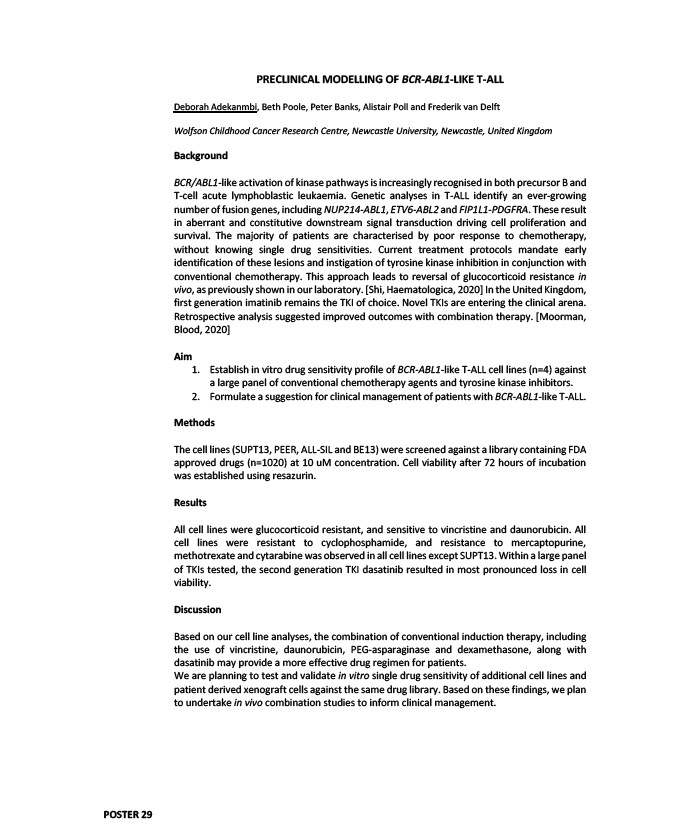
PRECLINICAL MODELLING OF BCR-ABL1-LIKE T-ALL
Deborah Adekanmbi, Beth Poole, Peter Banks, Alistair Poll and Frederik van Delft
Wolfson Childhood Cancer Research Centre, Newcastle University, Newcastle, United Kingdom
Background
BCR/ABL1-like activation of kinase pathways is increasingly recognised in both precursor B and
T-cell acute lymphoblastic leukaemia. Genetic analyses in T-ALL identify an ever-growing
number of fusion genes, including NUP214-ABL1, ETV6-ABL2 and FIP1L1-PDGFRA. These result
in aberrant and constitutive downstream signal transduction driving cell proliferation and
survival. The majority of patients are characterised by poor response to chemotherapy,
without knowing single drug sensitivities. Current treatment protocols mandate early
identification of these lesions and instigation of tyrosine kinase inhibition in conjunction with
conventional chemotherapy. This approach leads to reversal of glucocorticoid resistance in
vivo, as previously shown in our laboratory. Shi, Haematologica, 2020 In the United Kingdom,
first generation imatinib remains the TKI of choice. Novel TKIs are entering the clinical arena.
Retrospective analysis suggested improved outcomes with combination therapy. Moorman,
Blood, 2020
Aim
1. Establish in vitro drug sensitivity profile of BCR-ABL1-like T-ALL cell lines (n=4) against
a large panel of conventional chemotherapy agents and tyrosine kinase inhibitors.
2. Formulate a suggestion for clinical management of patients with BCR-ABL1-like T-ALL.
Methods
The cell lines (SUPT13, PEER, ALL-SIL and BE13) were screened against a library containing FDA
approved drugs (n=1020) at 10 uM concentration. Cell viability after 72 hours of incubation
was established using resazurin.
Results
All cell lines were glucocorticoid resistant, and sensitive to vincristine and daunorubicin. All
cell lines were resistant to cyclophosphamide, and resistance to mercaptopurine,
methotrexate and cytarabine was observed in all cell lines except SUPT13. Within a large panel
of TKIs tested, the second generation TKI dasatinib resulted in most pronounced loss in cell
viability.
Discussion
Based on our cell line analyses, the combination of conventional induction therapy, including
the use of vincristine, daunorubicin, PEG-asparaginase and dexamethasone, along with
dasatinib may provide a more effective drug regimen for patients.
We are planning to test and validate in vitro single drug sensitivity of additional cell lines and
patient derived xenograft cells against the same drug library. Based on these findings, we plan
to undertake in vivo combination studies to inform clinical management.
POSTER 29